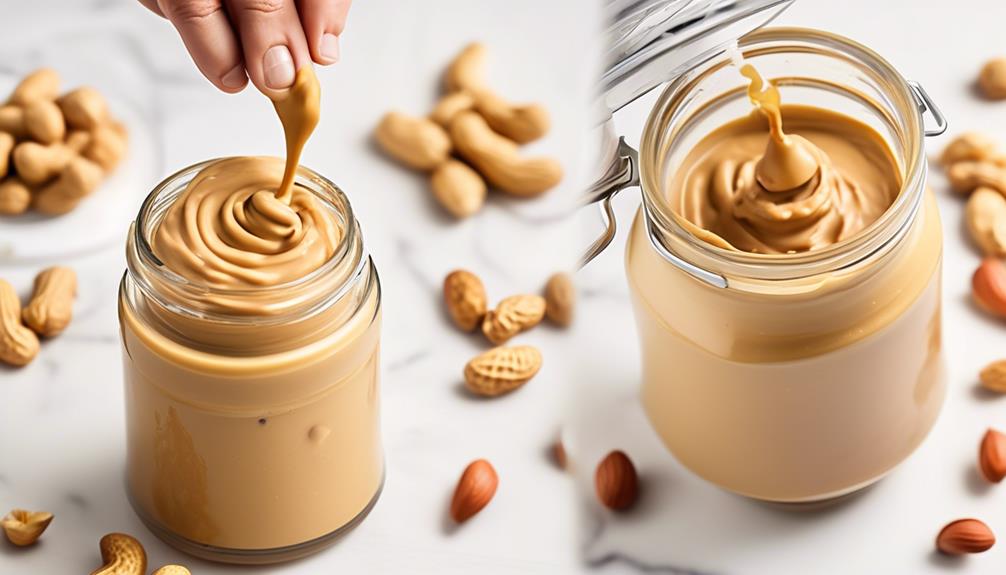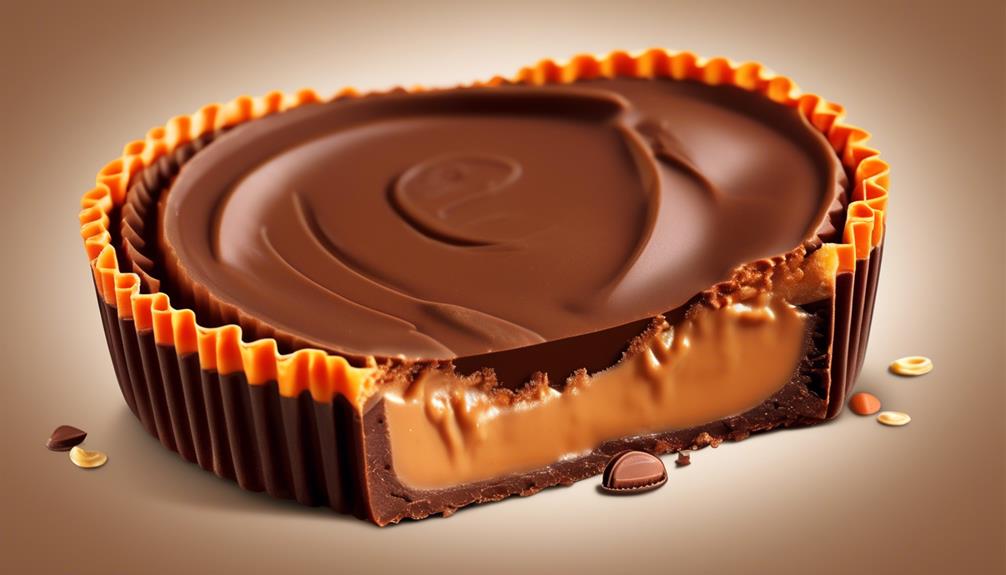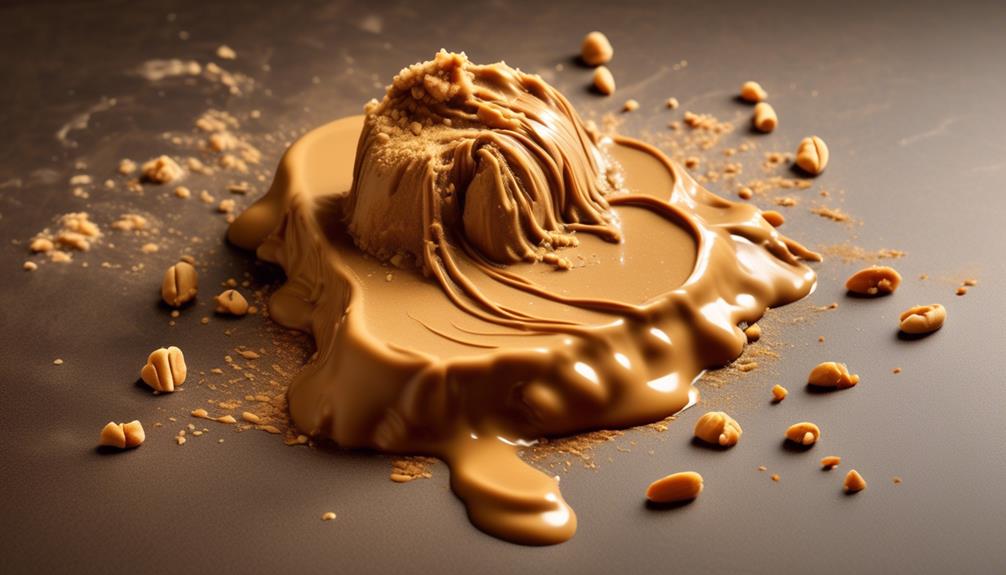Do you ever get annoyed when you open a jar of natural peanut butter and it’s all oily on top? We’ve all experienced that. But don’t worry, there are some useful tips to prevent your creamy, delicious peanut butter from separating.
By understanding the science behind the separation and implementing a few clever storage techniques, you can maintain that perfect, spreadable consistency without any hassle.
But wait, there's more – we'll also explore the role of emulsifiers and the potential impact of homemade versus commercial peanut butter. Stick around to uncover the secrets of peanut butter harmony.
Key Takeaways
- Natural peanut butter separates due to the absence of stabilizers and hydrogenated oils.
- Storing the jar upside down helps redistribute the oil evenly.
- Refrigeration can minimize separation by solidifying the oil.
- Emulsifiers, such as lecithin and mono- and diglycerides, prevent oil and solids separation and maintain a smooth consistency.
Understanding Peanut Butter Separation
Understanding peanut butter separation involves recognizing the natural process by which the oil in peanut butter tends to separate from the solids over time. This occurs due to the absence of stabilizers and hydrogenated oils, which are present in commercial peanut butter. When left undisturbed, the denser peanut solids settle at the bottom while the oil rises to the top.
To prevent this separation, the upside-down storage trick is an effective method. Storing the jar upside down causes the oil to trickle to the bottom, and when the jar is flipped right-side-up, it redistributes the oil evenly. This technique also applies to almond and cashew butter, as well as other natural nut butters.
Refrigeration is another preventive measure, as it solidifies the oil, minimizing separation. However, refrigeration may make the peanut butter harder to spread, so storing the jar upside down in the fridge can help distribute the oil evenly.
Prevention is key, and storing the jar upside down is a simpler solution than stirring. By understanding the natural process of separation and applying these methods, we can effectively prevent peanut butter from separating.
The Science Behind Peanut Butter Separation

Frequently, natural peanut butter separates due to the process of oils and solids separating, a phenomenon known as syneresis, which occurs in the absence of stabilizers. This separation anxiety is common in natural nut butters, including almond and cashew butter, as they lack the stabilizers found in commercial peanut butter.
The science behind peanut butter separation lies in the composition of the spread. Peanuts naturally contain oil, and when they're ground into butter, the oil and solids can separate over time. Real Simple suggests storing the jar upside down to aid in redistributing the oil when flipped back over. Refrigeration can also help prevent separation, but it may alter the spreadability.
To counter this, using an immersion blender or incorporating liquid soy lecithin during processing can help achieve a smooth consistency by bonding the peanuts and natural oils. Understanding the science behind peanut butter separation allows for practical solutions to maintain the desired texture and taste of natural peanut butter.
Factors Affecting Peanut Butter Consistency

When considering the consistency of peanut butter, the absence of stabilizers in natural peanut butter leads to the separation of oils and solids, impacting its texture over time. This separation, known as syneresis, is influenced by several factors:
- Storage method: Storing the jar upside down encourages the natural oils to trickle to the bottom, keeping the peanut solids on top and facilitating recombination when stirred. This method is applicable to other nut butters like almond and cashew butter, preventing oil separation and maintaining a consistent texture.
- Refrigeration: Storing natural peanut butter in the fridge can help to prevent separation by stabilizing the natural oils. However, it may also lead to a harder consistency, making it more challenging to spread.
- Re-emulsification: When separation occurs, re-emulsifying the peanut butter using an immersion blender or a food processor with a small amount of neutral oil can help restore its smooth, creamy consistency by reintegrating the natural oils with the solids.
Understanding these factors is crucial in maintaining the desired consistency of natural peanut butter, ensuring a smooth and enjoyable product for consumption.
Emulsifiers in Peanut Butter

How do emulsifiers contribute to the stability of peanut butter and prevent the separation of oil and solids? Emulsifiers play a crucial role in maintaining the homogeneity of peanut butter by preventing the oil and solids from separating. Commonly used emulsifiers, such as lecithin and mono- and diglycerides, work by binding the oil and water molecules together, thereby stabilizing the mixture. This prevents the oil from rising to the top of the jar, ensuring a consistent texture and appearance.
| Emulsifier Type | Function in Peanut Butter |
|---|---|
| Lecithin | Binds oil and water |
| Mono- & diglycerides | Stabilizes the mixture |
| Others | Varies by manufacturer |
The addition of emulsifiers results in a smooth and spreadable consistency that consumers expect from peanut butter. Without emulsifiers, the natural separation of oil from the solids would lead to an unappealing and inconvenient product. By incorporating these emulsifiers, peanut butter maintains its desired texture and appearance, providing a satisfying and consistent experience for consumers.
Storing Peanut Butter to Prevent Separation

Emulsifiers, such as lecithin and mono- and diglycerides, play a crucial role in maintaining the stability of peanut butter, and their efficacy can be complemented by specific storage methods to prevent separation.
When storing peanut butter to prevent separation, there are several effective techniques to consider:
- Upside-Down Storage: Storing the jar upside down allows the oil to rise to the bottom, making it easier to remix the contents when the jar is flipped back over.
- Re-Emulsification: After storing the jar upside down, flipping it back over and giving it a quick shake can help re-emulsify the peanut butter, preventing separation.
- Refrigeration: While refrigeration can help prevent separation, it's important to note that it may make the peanut butter harder to spread. However, for those who prefer a firmer texture, refrigeration can be an effective method for maintaining stability.
Mixing Techniques for Consistent Peanut Butter

Applying mixing techniques to achieve a consistent peanut butter texture involves strategic methods to prevent oil separation and ensure a homogenous blend of ingredients.
When dealing with natural peanut butter, it's essential to employ specific techniques to maintain a smooth, uniform texture. Storing the jar upside down is a practical method to allow the oil to rise to the bottom, reducing excessive separation. Additionally, frequent flipping and shaking of the jar helps redistribute the oil evenly throughout the peanut butter, preventing it from settling on the top.
Refrigeration can also aid in preventing separation by solidifying the oil and maintaining a more consistent texture. In cases where separation does occur, re-emulsifying the peanut butter using an immersion blender or a food processor can effectively blend the separated contents back together for a smooth consistency.
Moreover, considering the addition of liquid soy lecithin to the nuts can help bond the peanuts to any natural oils, further preventing separation and ensuring a consistent texture.
Natural Vs. Processed Peanut Butter Separation

Natural peanut butter commonly separates due to the oils and solids naturally separating, while processed peanut butters contain stabilizers to prevent separation.
Storing the jar upside down helps separate the oil and solids, allowing the oil to trickle to the bottom and staying on top when flipped right-side-up. This simple trick can be applied to almond and cashew butter as well, and storing these nut butters in the fridge can fully prevent separation.
Natural peanut butter containing only peanuts and salt is a healthier option compared to supermarket varieties with added ingredients. Refrigeration helps prevent separation, and re-emulsifying separated natural peanut butter can be achieved using an immersion blender or alternative methods.
These techniques ensure that the natural goodness and texture of the peanut butter are maintained, providing a delightful and nutritious spread for all your culinary creations.
Overcoming Oil Separation in Peanut Butter

We'll now address the methods for stabilizing natural peanut butter and achieving a consistent texture.
Emulsifiers play a crucial role in preventing oil separation, and proper mixing techniques can help maintain the desired consistency.
Emulsifier for Stability
To achieve stability and prevent oil separation in natural peanut butter, incorporating a liquid emulsifier such as soy lecithin, in an amount ranging from 0.25% to 0.5% of the total weight of nuts, is essential. This emulsifier helps to bind the peanut oil and solids together, preventing them from separating.
Here's how it works:
- Enhances Emulsification: Liquid soy lecithin acts as a stabilizing agent, enhancing the emulsification of the peanut oil and solids, thus preventing oil separation.
- Maintains Consistency: By incorporating the right amount of soy lecithin, the peanut butter maintains a consistent texture, making it easier to spread and enjoy.
- Extends Shelf Life: The addition of liquid soy lecithin not only prevents oil separation but also extends the shelf life of natural peanut butter, ensuring its quality over time.
Proper Mixing Technique
After incorporating the liquid emulsifier for stability, the proper mixing technique plays a pivotal role in overcoming oil separation in natural peanut butter.
To begin, store the jar upside down to allow the oil to rise to the bottom and peanut solids to remain on top. Once flipped over, give it a quick shake to re-emulsify the contents.
Refrigerating the mixed peanut butter can also prevent separation, but remember to store it right-side-up to maintain spreadability.
For more severe separation, consider using an immersion blender or a hand mixer to re-emulsify the natural peanut butter. It's important to avoid adding too much oil or sweetener when remixing separated peanut butter to maintain the desired consistency.
Managing Oil Layer in Homemade Peanut Butter

When managing the oil layer in homemade peanut butter, storing the jar upside down and then flipping it right-side-up to redistribute the oil evenly can help prevent separation. Natural oils tend to rise to the top of peanut butter over time, causing the familiar layer of oil. To ensure a consistent texture and taste, it's important to mix the oil back into the peanut butter.
Here's how to manage the oil layer effectively:
- Store the jar upside down: By storing the jar upside down, the natural oils will gather at the bottom of the jar. After a while, flip it right-side-up to redistribute the oils evenly throughout the peanut butter.
- Refrigerate the peanut butter: Refrigeration can help prevent separation, as the cooler temperature slows down the oil's tendency to rise. However, keep in mind that refrigeration may also make the peanut butter harder to spread.
- Use an immersion blender or food processor: If the oil does separate, using an immersion blender or a food processor can help blend the contents back together seamlessly.
Managing the oil layer in homemade peanut butter is a completely natural process, and by following these techniques, you can make sure your peanut butter stays well mixed and tasty.
Quality Control for Commercial Peanut Butter

As we consider the quality control for commercial peanut butter, it's crucial to focus on the points of ingredient stability, production process control, and shelf life management.
These aspects are fundamental in ensuring that the peanut butter remains well-mixed, doesn't separate, and maintains the desired consistency over time.
Ingredient Stability
Commercial peanut butter manufacturers use stabilizers to prevent the separation of oils and solids, ensuring product stability and quality. Stabilizers, such as hydrogenated oils or vegetable oil, are added to create an emulsion that keeps small particles suspended and prevents them from settling.
This process is crucial for maintaining a consistent texture and taste throughout the product's shelf life. Additionally, stabilizers help to prevent the natural oils in peanut butter from separating, which can lead to an unappealing appearance and negatively impact the overall product quality.
Production Process Control
Implementing stringent quality control measures during the production process is essential for ensuring the consistency and stability of commercial peanut butter.
For instance, it's crucial to implement ingredient quality control to ensure the peanuts used meet standards and are free from contamination.
Additionally, monitoring consistent moisture content in the peanuts prevents separation issues.
The emulsification process also plays a vital role, requiring thorough mixing to evenly distribute oil and solids, while temperature and storage control are crucial for maintaining stability and preventing oil separation.
Proper packaging and sealing, along with regular quality assurance testing for emulsion stability and product consistency, are also integral parts of production process control for commercial peanut butter.
This comprehensive approach ensures that the final product meets the specified quality standards.
Shelf Life Management
During the production process, strict quality control measures ensure the consistency and stability of commercial peanut butter. This attention to detail extends to the management of its shelf life to prevent separation issues.
- Monitoring: Regular testing for oil separation and texture changes throughout the shelf life.
- Packaging: Employment of suitable containers and seals to minimize exposure to air and moisture.
- Storage Guidelines: Providing clear instructions for consumers, including recommendations for temperature and proper storage techniques to maintain product integrity.
Extending Shelf Life of Peanut Butter

To extend the shelf life of peanut butter, storing the jar upside down or in the fridge can help prevent oil separation.
When peanut butter is stored upside down, the peanut oil has to travel through the peanut butter to reach the top of the jar, which can help in keeping the oil mixed in and prevent it from pooling on the top. This simple method can aid in maintaining the desired consistency of the peanut butter for a longer period.
Additionally, refrigerating natural peanut butter can also prevent separation, as the colder temperature slows down the oil separation process. However, it's important to note that refrigeration can make the peanut butter firmer, so it may be necessary to let it sit at room temperature for a few minutes before use.
Troubleshooting Peanut Butter Separation

When troubleshooting peanut butter separation, it's essential to address any issues that may arise from the methods used to extend its shelf life, such as storing it upside down or in the fridge.
Here are some key steps to troubleshoot peanut butter separation:
- Proper Storage Technique: Ensure the peanut butter jar is stored upside down to allow the oil to rise to the bottom. After storing upside down, flip the jar and give it a quick shake to re-emulsify the contents.
- Refrigeration Consideration: While storing in the fridge can help prevent separation, it may make the peanut butter harder to spread. Consider the trade-off between extended shelf life and spreadability when choosing the storage location.
- Emulsification Methods: If separation occurs, use an immersion blender or hand mixer to re-emulsify the contents. It's crucial to avoid adding too much oil or sweetener when remixing the separated butter to maintain its original consistency and flavor.
Frequently Asked Questions
How Do They Keep Peanut Butter From Separating?
We keep peanut butter from separating by utilizing various methods. Storing the jar upside down aids in redistributing the oil and solids.
Refrigeration helps prevent separation, but it can make the peanut butter harder to spread.
If separation occurs, we re-emulsify the peanut butter using an immersion blender or hand mixer at medium speed.
These techniques work not only for peanut butter but also for other nut butters like almond and cashew butter.
How Do You Emulsify Separated Peanut Butter?
To emulsify separated peanut butter, we have a few options. First, we can flip the jar over and shake it to redistribute the oil. If that doesn't work, we can use an immersion blender or hand mixer to blend the contents.
Storing the peanut butter in the fridge can help prevent separation, but it might make it harder to spread.
When remixing peanut butter, it's important to avoid adding excess oil or sweetener. Instead, we can try alternative methods like stirring vigorously, warming the peanut butter slightly, or adding a small amount of honey or maple syrup.
Is Peanut Butter Still Good After Separating?
Yes, peanut butter is still good after separating. Simply stir it well before use to evenly distribute the oil.
If you prefer a more uniform texture, consider storing it in the fridge or using an immersion blender to blend it back together.
While separation may occur, it doesn't affect the taste or safety of the peanut butter. Just be sure to give it a good mix, and it'll be as good as new.
Why Doesn't Jif Peanut Butter Separate?
Jif peanut butter doesn't separate due to its added stabilizers, like hydrogenated oils. These stabilizers help maintain a consistent texture and prevent the oil from separating.
Our team recommends storing the jar upside down to make stirring easier when using natural peanut butter. Refrigerating it can also help, but it might make spreading more difficult.
Adding liquid soy lecithin or using an immersion blender can prevent separation and achieve a smooth consistency in natural peanut butter.
Conclusion
In the battle against peanut butter separation, we must navigate the swirling currents of oil and solids. By understanding the science behind separation and utilizing proper storage techniques, we can steer clear of the treacherous waters of inconsistent texture.
Just as a skilled sailor navigates the choppy seas, we can expertly manage the oil layer in homemade peanut butter and ensure a smooth and creamy spread every time.










